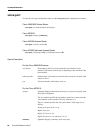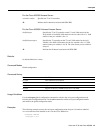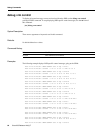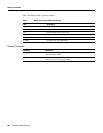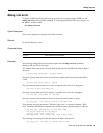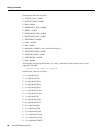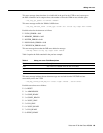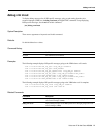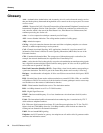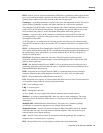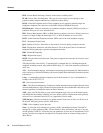
Glossary
Voice over IP for the Cisco AS5800 73
FIFO—First-in, first-out. In data communication, FIFO refers to a buffering scheme where the first
byte of data entering the buffer is the first byte retrieved by the CPU. In telephony, FIFO refers to a
queuing scheme where the first calls received are the first calls processed.
Gatekeeper—A gatekeeper maintains a registry of devices in the multimedia network. The devices
register with the gatekeeper at startup, and request admission to a call from the gatekeeper.
The gatekeeper is an H.323 entity on the LAN that provides address translation and control access
to the LAN for H.323 terminals and gateways. The gatekeeper may provide other services to the
H.323 terminals and gateways, such as bandwidth management and locating gateways.
Gateway—A gateway allows H.323 terminals to communicate with non-H.323 terminals by
converting protocols. A gateway is the point at which a circuit-switched call is encoded and
repackaged into IP packets.
An H.323 gateway is an endpoint on the LAN that provides real-time two-way communications
between H.323 terminals on the LAN and other ITU-T terminals in the WAN, or to another H.323
gateway.
H.323—An International Telecommunication Union (ITU-T) standard that describes packet-based
video, audio, and data conferencing. H.323 is an umbrella standard that describes the architecture of
the conferencing system, and refers to a set of other standards (H.245, H.225.0, and Q.931) to
describe its actual protocol.
H.323 RAS—Registration, admission, and status. The RAS signaling function performs
registration, admissions, bandwidth changes, status and disengage procedures between the VoIP
gateway and the gatekeeper.
HSRP—Hot Standby Routing Protocol. HSRP is a Cisco proprietary protocol which provides a
redundancy mechanism when more than one router is connected to the same segment/subnet of an
Ethernet/FDDI/Token Ring network.
ISDN—Integrated Services Digital Network. ISDN is a communications protocol, offered by
telephone companies, that permits telephone networks to carry data, voice, and other traffic.
ITU-T—Telecommunication standardization sector of ITU.
IVR—Integrated voice response. A software feature that allows the use of one of several interactive
voice response scripts during the call processing functionality.
LEC—Local exchange carrier.
LRQ—Location request.
MCU—Multipoint control unit
mu-law—a-law—A voice compression technique commonly used in North America.
Multicast—A process of transmitting PDUs from one source to many destinations. The actual
mechanism (that is, IP multicast, multi-unicast, etc.) for this process may be different for LAN
technologies.
Multilink PPP—Multilink Point-to-Point Protocol. This protocol is a method of splitting,
recombining, and sequencing datagrams across multiple logical data links.
Multipoint-unicast—A process of transferring Protocol Data Units (PDUs) where an endpoint
sends more than one copy of a media stream to different endpoints. This may be necessary in
networks which do not support multicast.
node—An H.323 entity that uses RAS to communicate with the gatekeeper. For example, an
endpoint such as a terminal, proxy, or gateway.
PDU—Protocol Data Units. Used by bridges to transfer connectivity information.




